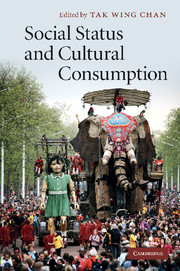Book contents
- Frontmatter
- Contents
- List of figures
- List of tables
- List of contributors
- Acknowledgments
- 1 Social status and cultural consumption
- 2 The social status scale: its construction and properties
- 3 Social stratification and musical consumption: highbrow–middlebrow in the United States
- 4 Bourdieu's legacy and the class–status debate on cultural consumption: musical consumption in contemporary France
- 5 Social status and public cultural consumption: Chile in comparative perspective
- 6 Social stratification and cultural participation in Hungary: a post-communist pattern of consumption?
- 7 Status, class and culture in the Netherlands
- 8 Social stratification of cultural consumption across three domains: music; theatre, dance and cinema; and the visual arts
- 9 Conclusion
- References
- Index
2 - The social status scale: its construction and properties
Published online by Cambridge University Press: 07 May 2010
- Frontmatter
- Contents
- List of figures
- List of tables
- List of contributors
- Acknowledgments
- 1 Social status and cultural consumption
- 2 The social status scale: its construction and properties
- 3 Social stratification and musical consumption: highbrow–middlebrow in the United States
- 4 Bourdieu's legacy and the class–status debate on cultural consumption: musical consumption in contemporary France
- 5 Social status and public cultural consumption: Chile in comparative perspective
- 6 Social stratification and cultural participation in Hungary: a post-communist pattern of consumption?
- 7 Status, class and culture in the Netherlands
- 8 Social stratification of cultural consumption across three domains: music; theatre, dance and cinema; and the visual arts
- 9 Conclusion
- References
- Index
Summary
In Chapter 1, John Goldthorpe and I argue that one weakness of previous research into the social stratification of cultural consumption relates to inadequacies in the way in which stratification has been conceptualised and, in turn, treated in empirical analyses. The source of these inadequacies, we further argue, is a failure to maintain the Weberian distinction between class and status (Weber, 1968, vol. 2; pp. 926–939 esp.). Following Weber, we expect the social stratification of cultural consumption to be based on social status rather than on social class.
The contributors to the present collection all accept this argument. Each national team has constructed a status scale for their country which will be used as a key explanatory variable, along with social class, education and income, in the chapters that follow. Given the pivotal role that is played by social status in our explanatory framework, the aim of this chapter is to describe the status scales in some detail. I begin with a discussion of how the scales are empirically estimated. I then describe some key properties of the status scales, addressing questions such as whether the sub-populations of a society share the same status order, and how social status, in the classical Weberian sense, relates to other stratification variables; principally education, income, ‘socioeconomic status’ and social class. I will also discuss, albeit in an informal manner, the extent of cross-national commonality and variation in social status. In the concluding section of this chapter, I compare our status scales with other occupational scales that are in use in empirical sociological research.
- Type
- Chapter
- Information
- Social Status and Cultural Consumption , pp. 28 - 56Publisher: Cambridge University PressPrint publication year: 2010
- 12
- Cited by



